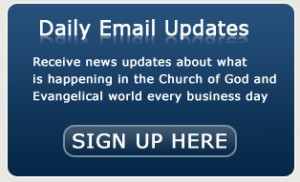The Building of Angelus Temple
By the end of 1921, the words “Echo Park Revival Tabernacle” no longer stood for a fond but distant dream. The building was fast becoming a blessed and concrete reality, a solid base for the evangelistic work the Master had placed in my hands. How eager and anxious I was after another strenuous series of eastern campaigns and the transcontinental trip through snow and sleet to reach Los Angeles, where I lost no time speeding to the tabernacle site.
Echo Park loomed ahead, but it was not the park or the lake that gripped my attention. I was straining for the first glimpse of the tabernacle. Yes, there it was—that large, circular property just at the entrance to the park. How ideal its location!
“Just think!” I exclaimed. “It hasn’t been a year since the first announcement of the proposed tabernacle was made, and now the walls are going up!”
About the middle of 1922, the tentative name “Echo Park Revival Tabernacle” was dropped in favor of the enduring name “Angelus Temple.” I had two thoughts in mind in naming the building Angelus Temple. First, the Angelus, the ringing of bells, ringing from the belfry, calling people to come to church. But my principle thought was the second—the Angel’s Temple.
Anyone visiting the church will notice that bells and angels predominate the decorations within. There is a frieze work with bells on the front of each balcony. And angels are painted at the top of the walls, standing wing-to-wing, representative of a little glimpse beyond the veil.
Because the Foursquare Gospel means Foursquare Good News, I did not want anything sad in the decoration of Angelus Temple. When it came time to choose the central motto to appear over the platform, someone suggested, “Woe, all have sinned and come short of the glory of God.” But we all know that, and anyway, that would not be good news.
What is the heart of the Good News? The Good News focuses on this point: “Jesus Christ the same yesterday, and today, and forever.” That verse would be the scriptural motto of The Foursquare Church. I wanted Angelus Temple itself to be an illustrated sermon so that if anyone came into the temple who was deaf, he could see the story of Jesus and the way of salvation. And many have!
The decoration of the dome engaged my attention. Some wanted to make it a night scene with the stars shining. That might have been beautiful but more likely would have proved gloomy. I said, “No, I want it to represent the day, that it might speak to us of the Scripture, ‘Work while it is yet day, for the night cometh when no man can work.’ ” So it was painted as the blue sky with white fleecy clouds, to remind us that Jesus is coming in the clouds of glory.
I wanted to tell the whole story of the Good News in such a way that if anybody should come when no one was here to preach, he would be able to look around and see the gospel. Stained-glass windows would contribute to this effect! The windows could not be installed in time for the dedication of the temple, but in a few months all were put in place.
After designing the windows, I realized that some might wonder, “How is Jesus coming?” So we took 40 feet, interrupting the organ grill, for a mural painting showing Jesus Christ accompanied by the hosts of heaven with their long, slender trumpets. Jesus appears in the center with outstretched hands.
Weeks before the official opening, Christian workers commended flocking to the temple for preliminary activities. The choir began rehearsing. An information bureau opened at the main entrance on Park Avenue on Dec. 15, where musicians, ushers and other helpers might register for service.
A two weeks’ convention was scheduled for the opening of Angelus Temple, with ministers from all over the country—Methodists, Baptists, Congregationalists, United Brethren and others who had participated in our evangelistic campaigns—sharing the pulpit with me.
The year 1922 was fast fading into history. The New Year would soon dawn, and with it the dedication of Angelus Temple.
—————————————————————-
Adapted from Aimee: The Life Story of Aimee Semple McPherson by Aimee Semple McPherson, copyright 1979. Published by the International Church of the Foursquare Gospel.
This article was used with permission by The Foursquare Church.
(Source: Charisma Media)




